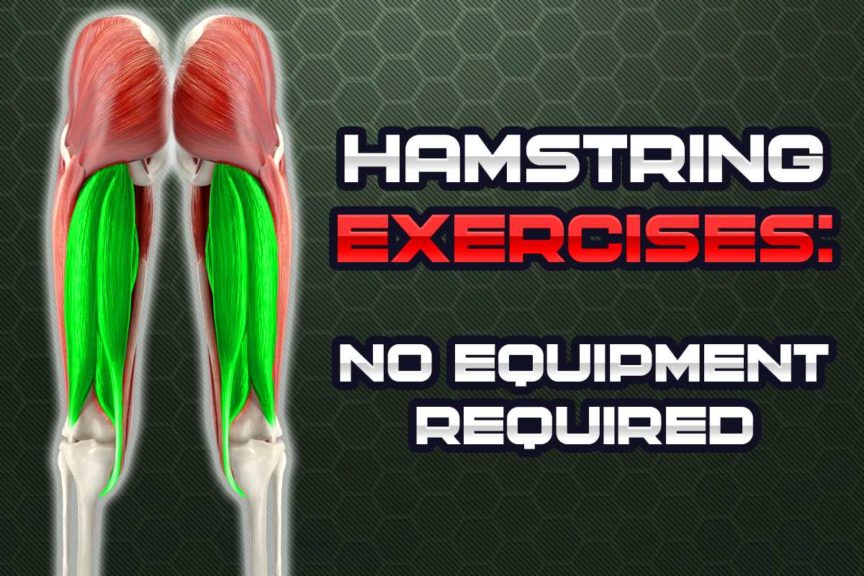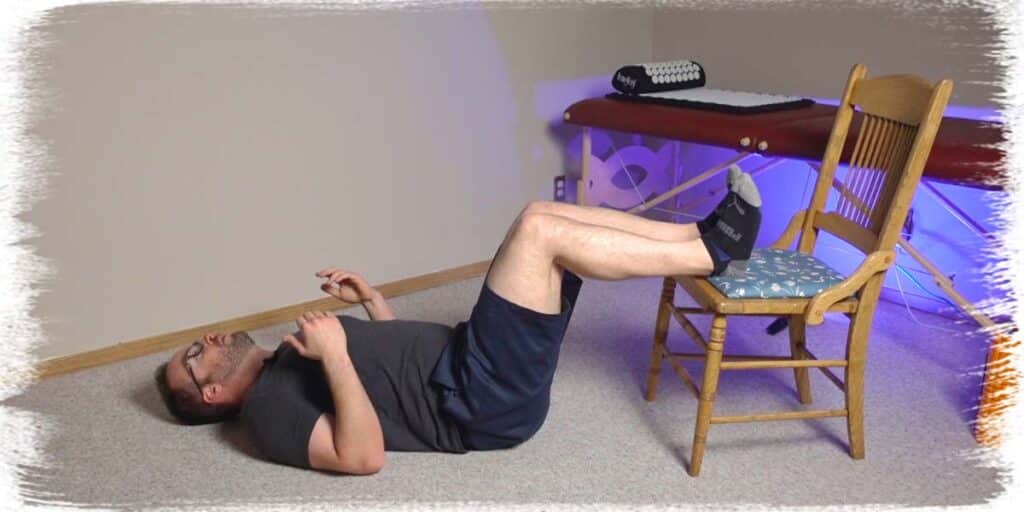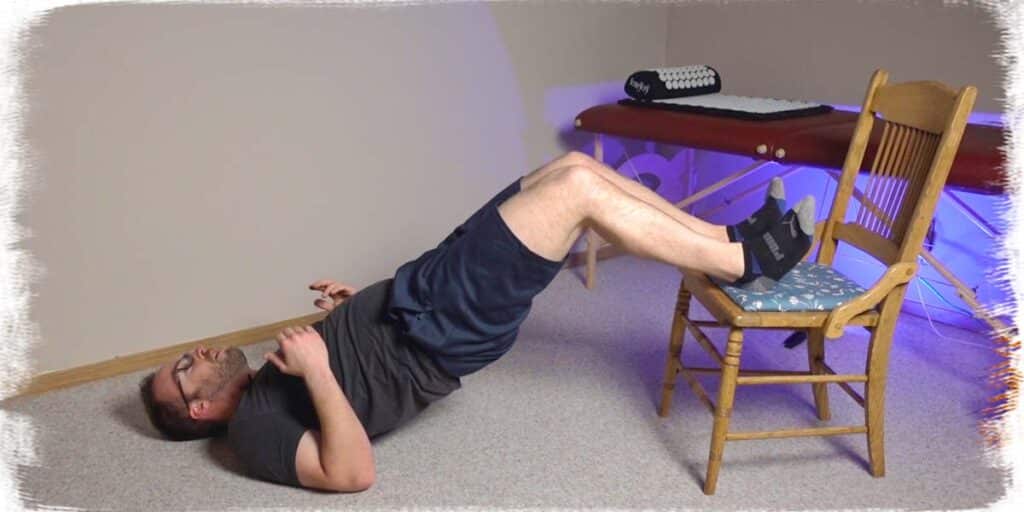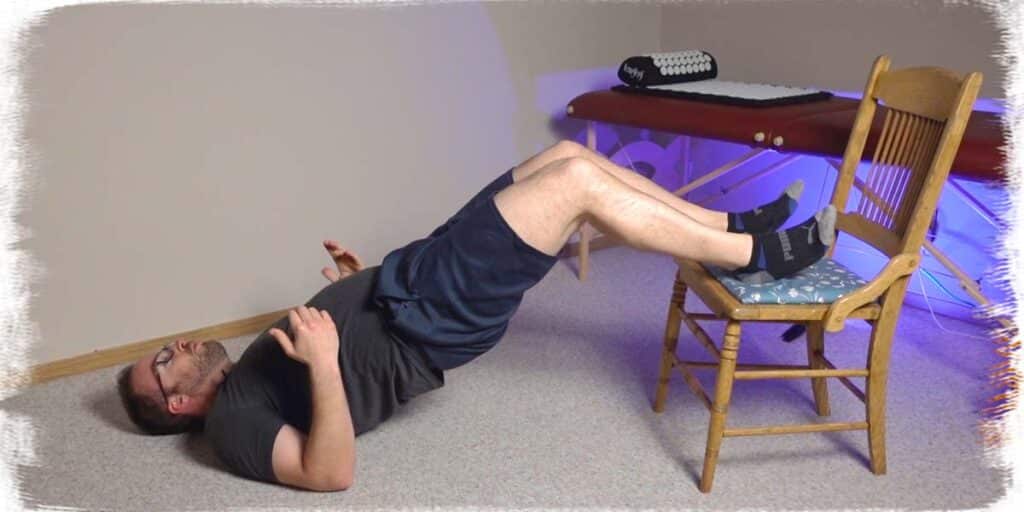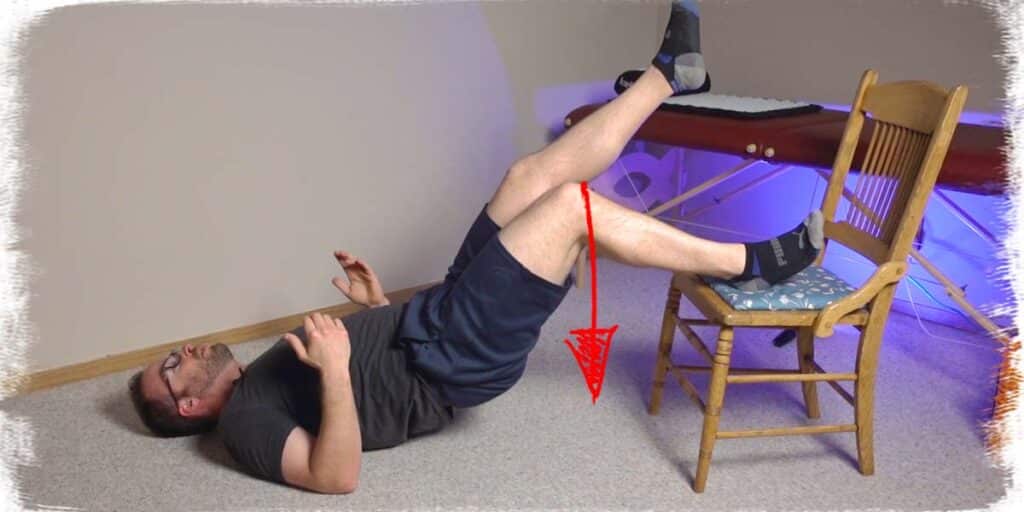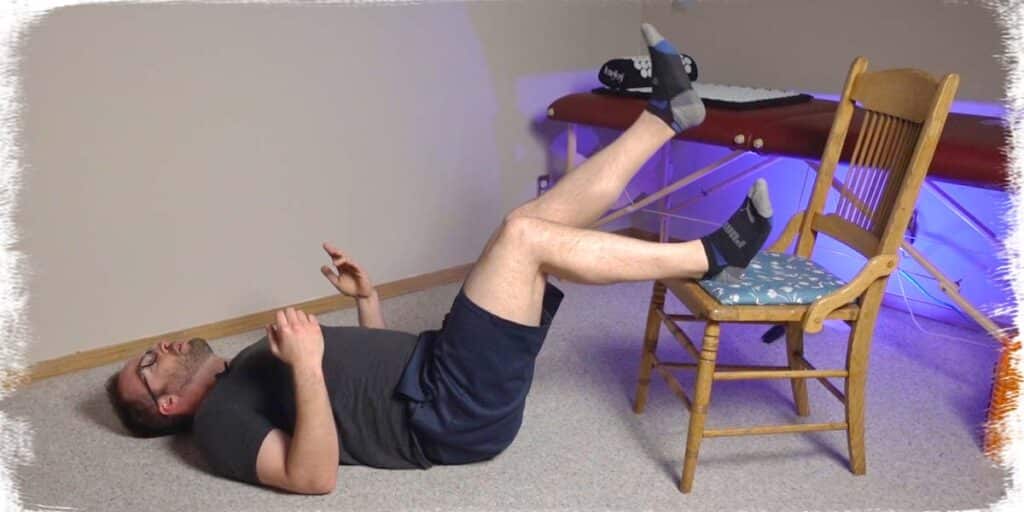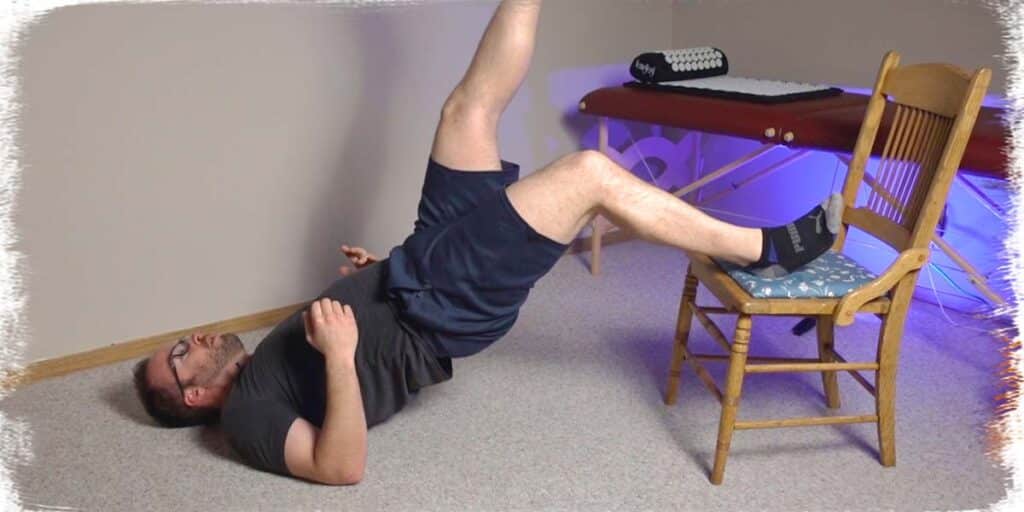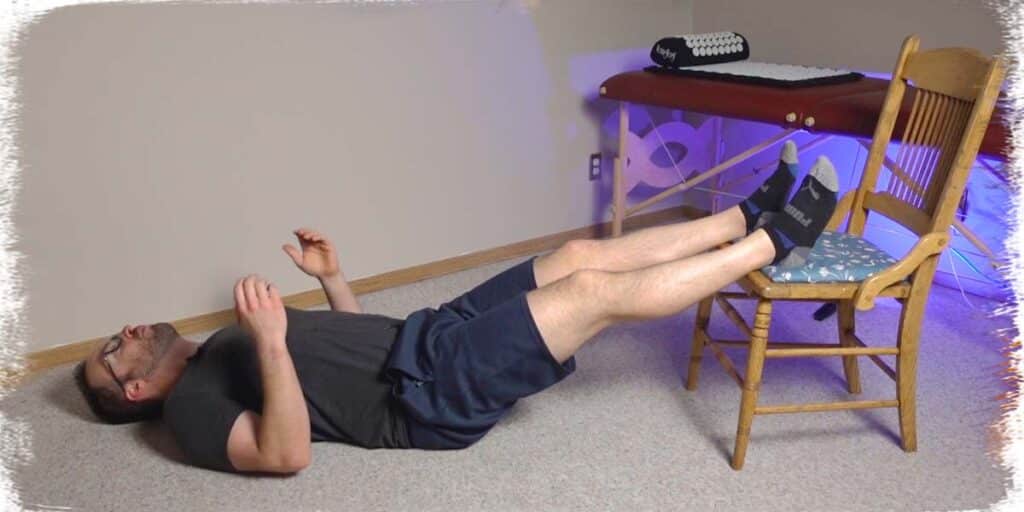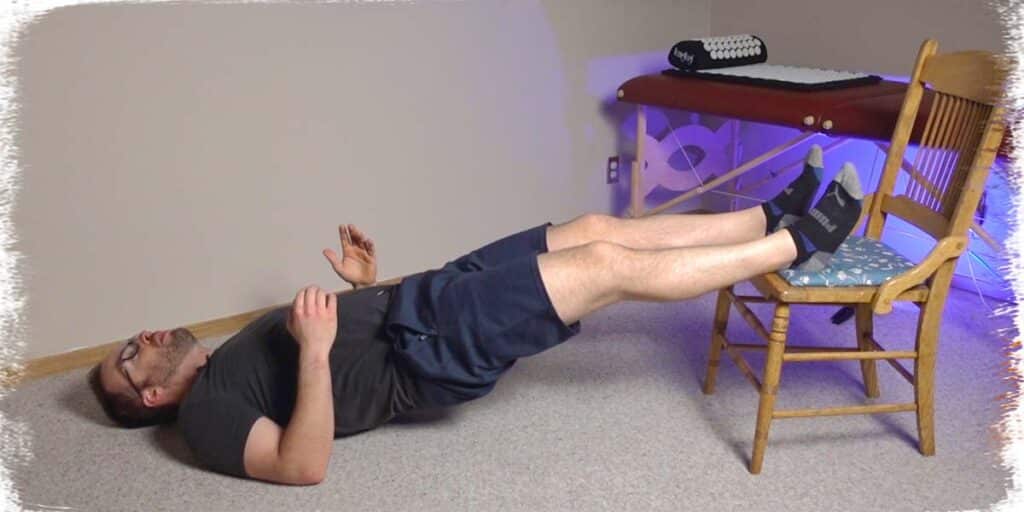Time to absolutely light up your hamstrings! This article will go over an immensely effective hamstring exercise that you can do right at home without any type of exercise equipment at all.
Ok, so you WILL need a chair or bench of some kind, but everyone has one of those, and it’s not exactly a piece of specialized fitness equipment. But we’re going to use it as one in this article, and your hamstrings are going to absolutely feel the challenge. So get ready for an exercise that can be done by beginners and experts alike due to its ability to be finely tuned to the needs of each individual. Seriously, don’t knock this exercise until you’ve tried it!
The best hamstring exercise you could ever do without any fitness equipment is the bent-knee hip extension with your feet on a chair. It can be modified in numerous ways based on how much or little challenge is needed and is as simple to perform as it is challenging.
If you want the precise details of performing this exercise, be sure to keep on reading. I’ll be covering three different progressions you can use, based on how much of a challenge you need.
ARTICLE OVERVIEW (quick links)
Click/tap any of the following headlines to instantly jump to that section of the article!
What makes the bent-knee hip extension so effective?
Level 1: The double-leg up and down
Level 2: The double-leg up and single leg down
Level 3: The single-leg up and down
Bonus: The straight-leg hip extension
Related article: Motivate Yourself to Workout at Home: Pro Tips to Get Fired Up!
What makes the bent-knee hip extension so effective?
Each of the three hamstring muscles is known as a two-joint muscle. This means that these three muscles (the semitendinosus, semimembranosus, and the biceps femoris) that comprise the hamstrings cross over two different joints. These joints that they cross over are the hip joint and the knee joint.
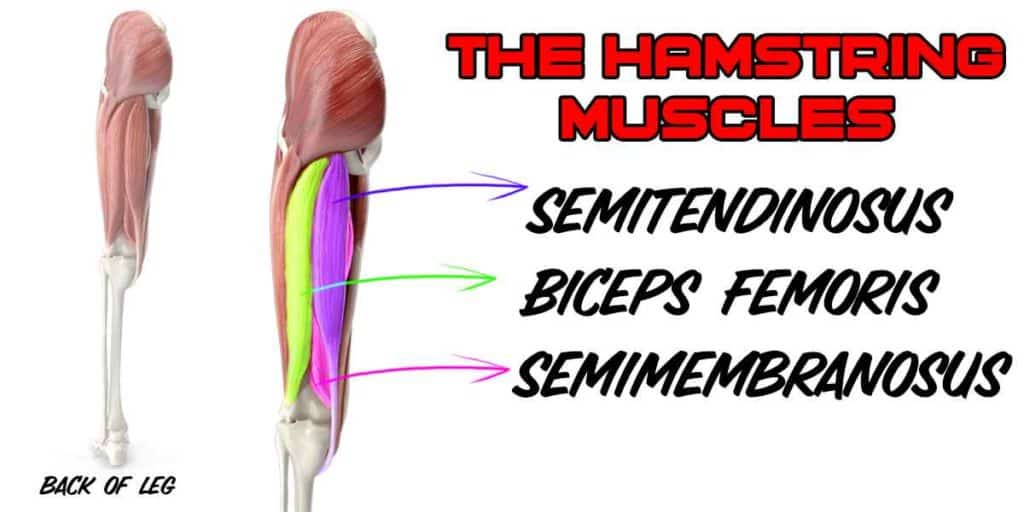
Whenever a muscle crosses over a joint (two bones that meet), that muscle affords the ability to moves the joint whenever the muscle contracts. This means that the hamstrings can extend (pull backwards) the hip (such as when running or walking) and also flex (bend) the knee. Therefore, the hamstrings have the unique ability to control both of these two individual joints.
So, suppose we devise an exercise that challenges the knee with bending and the hip joint with extending in the same movement. In that case, we can really, really challenge the hamstring muscles. This is where the bent-knee hip extension exercise comes in.
By forcing the knee to stay bent at 90-degrees (resist straightening out) through the following exercise (while simultaneously forcing the hip to extend), we are asking the hamstring muscles to work extra hard, which you will undoubtedly feel. The knees can only stay bent to 90 degrees throughout the movement due to the continual need for the hamstrings to contract to hold them in that position. If the knees straighten out, the hamstrings won’t have to contract nearly as aggressively (work as hard) throughout the exercise.
If that’s a bit hard to follow, don’t sweat it, just try the following exercise (along with the progressions, if appropriate), and you’ll likely feel to an exact extent what I mean.
Level 1: The double-leg up and down
Level 1 of this exercise is the easiest of the three levels of progressions. Here’s how to perform it:
- Start by laying on the ground with your heels up on a chair or bench.
- Bend your knees to 90 degrees and be sure to keep them in this position throughout the entire movement
- Push your hips straight up in the air as high as possible.
- Once you’ve gone as high as you can, hold this position for a second or two.
- Slowly lower your hips back down to the starting position and repeat.
- Perform as many reps as you require. (I tend to do between 10 – 15.)
Remember: don’t let your knees straighten out at all throughout the entire movement. Instead, they should stay bent to 90 degrees the whole time.
Level 2: The double-leg up, single leg down
If level 1 isn’t enough for you, or you feel that you’ll quickly outgrow it, give level 2 a try. It kicks things up a notch by placing a heavy eccentric contraction on the hamstrings. An eccentric contraction refers to the controlled lengthening of a muscle. Eccentric contractions are very demanding on muscles and, as a result, a great way to increase their overall strength.
- Start in the same position as level 1, laying on the ground with your heels resting on a chair or bench.
- Push your hips up in the air as high as possible (exactly the same as level 1)
- Once your hips are as high as they can go, lift one leg off the chair/bench.
- Next, slowly lower yourself back to the starting position using the one leg in contact with the chair/bench. Be sure to go as slow as possible to effectively challenge the hamstrings
- Repeat for as many repetitions as needed or desired.
You can opt to perform all repetitions on the same leg before switching over to the other leg and repeating the process, or you can alternate legs on each rep.
Pro tip: The slower you lower yourself down, the more challenging the exercise becomes. Resist the urge to let gravity pull you back down quickly!
Level 3: The single-leg up and down
If you’re feeling like a true rockstar, have some robust hamstrings or just really want to light up your hamstrings, level 3 is the ticket. Make sure that you can comfortably complete level 2 for a handful of reps with each hamstring before giving level 3 ago.
For level 3, you’re going to be performing the exercise in the exact same sequence as you did with level 1 – except you’ll be doing the entire movement on a single leg from start to finish.
Just like with level 2, you can opt to perform all repetitions on the same leg before switching to the other leg, or you can alternate legs on each rep. Either way that you do it, it’s time to feel the burn!
Bonus: The straight-leg hip extension
If you want to target your upper hamstrings a bit more than the lower hamstrings (the bent-knee hip extension emphasizes more of the mid-to-distal portion), then the straight-leg version is for you.
You may also find this version a bit easier to perform than the bent-knee version, so if the bent-knee version was a bit too much for you, it’s worth giving the straight-leg version a shot.
The progressions (levels) are precisely the same as with the bent-knee version. The overall exercise is performed in the same manner, except with your legs now being straight.
By keeping the legs straight, a bit more emphasis is shifted to the upper portion of the hamstrings, which you’ll likely feel when contrasted to the bent-knee version. Both versions are outstanding and effective in their own ways, so don’t think of one being better than the other; think of them as teammates who both work to serve your hamstrings well.
If you’re feeling like your hamstrings are pretty healthy, you can even try considering doing both of these exercises as part of your workout. You can do this as either two separate, distinct exercises or as a sort of back-to-back exercise (often called a compound set). Find what works best for you, and have fun blasting those hamstrings!
Final thoughts
You don’t need fancy, hamstring-specific equipment to challenge your hamstrings. Whether you’re looking for strengthening, endurance, injury prevention or injury recovery, this home exercise progression can be a great way to give you everything your hamstrings require, sans equipment.
In fact, this exercise works so well that I often use it on myself and my patients in the clinic, even when there’s access to other specialized equipment. Don’t doubt its effectiveness just because it requires no special equipment or seems very simple to do. Once you’ve tried a handful of repetitions, your hamstrings will let you know just how humbling (but effective) of an exercise it can be!

Hi! I’m Jim Wittstrom, PT, DPT, CSCS, Pn1.
I am a physical therapist who is passionate about all things pertaining to strength & conditioning, human movement, injury prevention and rehabilitation. I created StrengthResurgence.com in order to help others become stronger and healthier. I also love helping aspiring students and therapists fulfill their dreams of becoming successful in school and within their clinical PT practice. Thanks for checking out my site!

